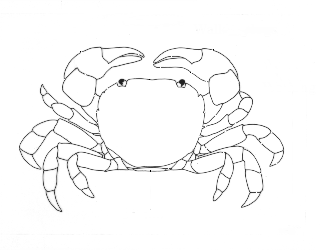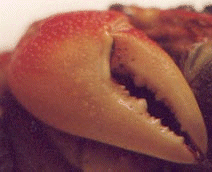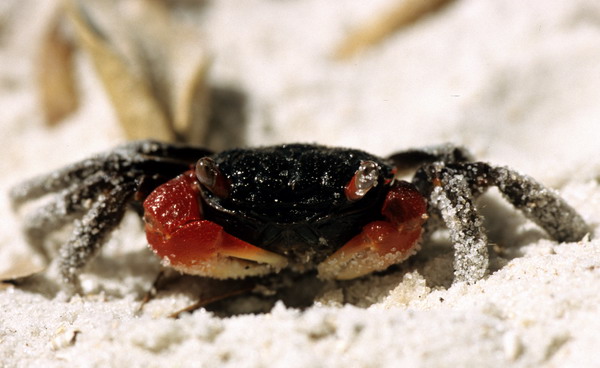
|
A field guide to Kenyan
mangroves
|
|
Neosarmatium africanum Ragionieri, Fratini, & Schubart 2012
(formerly N. meinerti De
Man, 1887)
Family: Sesarmidae

Zone: This large mangrove crab inhabits the landward Avicennia marina - upper shore - and is common in this zone.
Habitat: Burrowing to about 1 meter depth (Gillikin, 2000).
Food: Readily consumes leaf litter (Gillikin, 2000) and propagules (Dahdouh-Guebas et al., 1997) and has been known to feed on sediment (Steinke et al., 1993) and other crustaceans (Dahdouh-Guebas et al., 1999).
| Ecological notes: Much work has been done on this species (e.g. Cott, 1929; Alexander and Ewer, 1969; Gross et al., 1966; Hogue and Bright, 1971; Pereyra Lago, 1989; Micheli et al., 1991; Steinke et al., 1993; Emmerson and McGwynne, 1992; Dahdouh-Guebas et al., 1998, 1999; Skov, 1999; Gillikin, 2000). Their burrows are described in Gillikin (2000) and their burrowing behavior has been studied by Micheli et al. (1991). They found that this crab (maximum carapace width 4 cm) spends a significant amount of time maintaining its burrow, which lasts approximately three weeks before collapsing, and that they displace and mix up, one quarter of the upper 20 cm of soil per year (assuming most activity is confined to this depth). Neosarmatium africanum burrows are smaller (4 to 6 cm in diameter) than C. carnifex burrows, more irregular in shape and are never hooded (Micheli et al., 1991). Additionally, excavation pellets of N. africanum are round while those of C. carnifex are rod-shaped (Hogue and Bright, 1971). This species has also been shown to be important in leaf-litter removal (Micheli et al., 1991; Emmerson and McGwynne, 1992; Steinke et al., 1993), capable of removing more leaves than the trees can produce (Olafsson et al., 2002). Additionally, Hartnoll (1975) reports this species as being common in areas of freshwater influence. They can survive salinities as high as 65 for one month, but not without high energy expenditure, which probably would result in eventual death (Gillikin et al., in press). Burrow associates include: Sesarma ortmanni (Gillikin, 2004), mosquito larvae and amphipods (Gillikin, 2000). |
|
Distinguishing characteristics: Size (carapace width about 4cm); lacks two prominent spines on top of claw that N. smithi has; bright red borders on carapace; claw beige tipped.
 Claw detail |
 |

Geographical range: N. africanum is only found in Africa. Previously, this species was lumped with the N. meinert complex which is present in the Indo-Pacific including northern Australia (Vannini and Valmori, 1981; Davie, 1994). However, recent work by Ragionieri et al. (2012) have split this into 4 new species, with N. africanum being the African species (East Africa, South Africa, and Madagascar).

Photo: Mark Kuiper (www.natuurbeleven.nl)
References:
Alexander, S.J., and D.W. Ewer, 1969. "A comparative study of some aspects of the biology and ecology of Sesarma catenata Ort. and Cyclograpsus punctatus M.Edw., with additional observations on Sesarma meinerti De Man." Zool. afr. 4: 1-35.
Cannicci, S., F. Dahdouh-Guebas and L. Montemagno, 1993. "Field Keys for Kenyan Mangrove Crabs." Museo Zoologico "La Specola", Dipartimento di Biologia Animale e Genetica dell'Università Degli Studi di Firenze, Via Romana 17, I-50125 Firenze, Italia.
Cott, H.B., 1929. "The zoological society's expedition to the Zambesi, 1927: No. 2. Observations on the natural history of the land crab Sesarma meinerti, from Beira, with special reference to the theory of warning colours." Proceedings of the Zoological Society of London 1929: 679-692.
Dahdouh-Guebas, F., M. Verneirt, J.F. Tack & N. Koedam, 1997. "Food preference of Neosarmatium meinerti de Man (Decapoda: Sesarminae) and its possible effect on the regeneration of mangroves." Hydrobiologia 347:83-89.
Dahdouh-Guebas, F., M. Verneirt, J.F. Tack, D. Van Speybroeck and N. Koedam, 1998. "Propagule predators in Kenyan Mangroves and their possible effects on regeneration." Marine and Freshwater Research 49:345-350.
Dahdouh-Guebas, F., M. Giuggioli, A. Oluoch, M. Vannini & S. Cannicci, 1999. "Feeding habits of non-ocypodid crabs from two mangrove forests in Kenya." Bull. Mar. Sci. 64(2): 291-297.
Dahdouh-Guebas, F., M. Verneirt, S. Cannicci, J.G. Kairo, J.F. Tack & N. Koedam, 2002. An explorative study on grapsid crab zonation in Kenyan mangroves. Wetlands Ecology and Management 10: 179-187.
Davie, P.J.F., 1994. "Revision of Neosarmatium Serène and Soh (Crustacea: Brachyura: Sesarminae) with descriptions of two new species." Memoirs of the Queensland Museum 35:35-74.
Emmerson, W.D. and L.E. McGwynne, 1992. "Feeding and assimilation of mangrove leaves by the crab Sesarma meinerti De Man in relation to leaf-litter production in Mgazana, a warm-temperate southern African mangrove swamp." Journal of Experimental Marine Biology and Ecology 157: 41-53.
Gillikin, D.P., 2000. Factors controlling the distribution of Kenyan brachyuran mangrove crabs: Salinity tolerance and ecophysiology of two Kenyan Neosarmatium species. M.Sc. Thesis, Free University of Brussels, Brussels, Belgium.
Gillikin, D.P., 2004. Osmoregulatory ability of Chiromantes ortmanni (Crosnier, 1965) subjected to dilute and hypersaline seawater. Crustaceana 77(1): 67-74.(REPRINT)
Gillikin, D.P., B. De Wachter and J.F. Tack, 2004. Physiological responses of two ecologically important Kenyan mangrove crabs exposed to altered salinity regimes. Journal of Experimental Marine Biology and Ecology 301(1):93-109. (http://authors.elsevier.com/sd/article/S002209810300474X) (REPRINT)
Gross, W.J., R.C. Lasiewski, M. Dennis and P. Rudy Jr., 1966. "Salt and water balance in selected crabs of Madagascar." Comparative Biochemistry and Physiology 17: 641-660.
Hartnoll, R.G., 1975. "The Grapsidae and Ocypodidae (Decapoda: Brachyura) of Tanzania." J. Zool. Lond. 177:305-328.
Hogue, CL & Bright, DB. 1971. Observations on the biology of land crabs and their burrow associates on the Kenya coast. Los Angeles County Natural History Museum, Contributions in Science 210: 1-10.
Micheli, F., F. Gherardi, and M. Vannini, 1991. "Feeding and Burrowing Ecology of Two East African Mangrove Crabs." Marine Biology 111:247-254.
Olafsson E, Buchmayer S, Skov MW, 2002. The East African decapod crab Neosarmatium meinerti (de Man) sweeps mangrove floors clean of leaf litter. AMBIO 31 (7-8): 569-573.
Pereyra Lago R.P., 1989. "The larval development of the red mangrove crab Sesarma meinerti de Man (Brachyura: Grapsidae) reared in the laboratory." S. Afr. J. Zool. 24(1):199-211.
Ragionieri, L., S. Fratini, C.D. Schubart, 2012. "REVISION OF THE NEOSARMATIUM MEINERTI SPECIES COMPLEX (DECAPODA: BRACHYURA: SESARMIDAE), WITH DESCRIPTIONS OF THREE PSEUDOCRYPTIC INDO–WEST PACIFIC SPECIES." THE RAFFLES BULLETIN OF ZOOLOGY 60(1): 71–87. (REPRINT)
Skov, M.W., 1999. The influence of methodology, tidal phase, season and animal sex on density estimates of Neosarmatium meinerti (De man). In: Conference on advances on marine sciences in Tanzania., IMS, Zanzibar (Tanzania), 1999, p. 10.
Steinke, T.D., A. Rajh and A.J. Holland, 1993. "The feeding behaviour of the red mangrove crab Sesarma meinerti, de Man, 1887 (Crustacea: Graspidae) and its effect on the degradation of mangrove leaf litter." S. Afr. J. mar. Sci. 13:151-160.
Vannini, M. and P. Valmori, 1981. Researchers on the coast of Somalia. The shore and the dune of Sar Uanle. 30. Grapsidae (Decapoda Brachyura). Monitore Zoologico Italiano 6: 57-101.